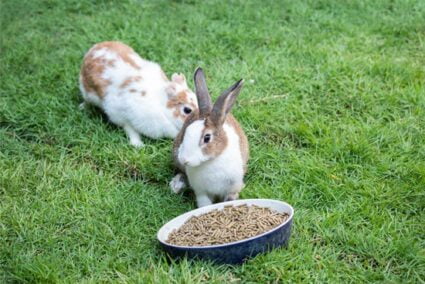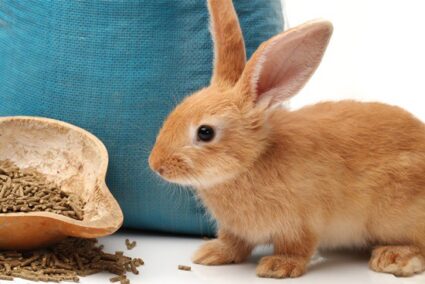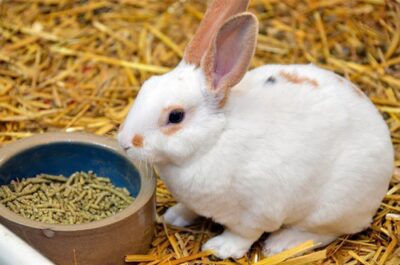Pellets are a popular food for rabbits. Alongside fresh hay and leafy greens, pellets are one a rabbit’s most favorite foods. So, it’s concerning if your rabbit stops eating her pellets all of a sudden.
Your rabbit is likely bored with pellets. Changing the brand or smearing something sweet on the pellets can stimulate the appetite. Feed your pet somewhere private, and don’t make pellets available 24/7 as scarcity makes food more interesting to a rabbit.
Pellets are not critical to a rabbit’s diet as they’re not eaten in the wild. But, if a rabbit stops eating pellets overnight, it’s worth investigating what’s affecting her appetite.
Are Pellets Vital To a Rabbit’s Diet?
Pellets are most crucial to rabbits while the animal is young. For the first few months of your pet’s life, she should be provided with unlimited pellets. She can eat as many of these as she sees fit.
While your rabbit is still young, pellets are highly beneficial. They provide a rabbit with protein and calcium, and are high in calories. This helps your rabbit to gain weight and muscle mass.
Despite this, pellets will always be less critical than fresh hay and green vegetables. The House Rabbit Society has a helpful food pyramid that elaborates upon this hierarchy. While some rabbits love pellets, they are not a compulsory part of the diet.
When your rabbit reaches maturity, her access to pellets should be reduced. Pellets are high in calories. This means that your rabbit will rapidly gain weight if she eats too many.
Also, adult rabbits need considerably less protein and calcium than babies. In fact, too much can be harmful. This is why access to hay needs to be increased and pellets reduced. An adult rabbit needs plenty of fiber, and not much else.
What Makes an Ideal Rabbit Pellet?
If you decide to feed your rabbit pellets, make sure they are of sufficient quality. Like all pet foods, some pellets are better for your rabbit than others.
Avoid pellets with dried fruit, nuts, etc. Your rabbit will pick out the tasty ingredients and ignore the healthy remainder. The key qualities to high quality, appealing pellets are:
- Freshness. Pellets can turn moldy quite quickly. Never keep stock for more than six weeks old. In addition, always keep your pellets in a cool, dry location.
- Fiber. Pellets should contain a minimum of 18% fiber. More is better.
- Protein. If your rabbit is young, look for a protein count of around 16%. Older rabbits need closer to 12 or 14%.
- Fat. The lower the fat percentage, the better. 5% is the maximum. Aim for half this amount.
- Calcium and Phosphorus. These vitamins must have an appropriate ratio. The pellets should contain 1.5 or 2 times as much calcium. Never go above 1% calcium.
Ensure that the pellets use grass-based ingredients. These will boost digestion. If you stick to these rules, your rabbit’s life and diet and diet will be suitably enhanced.

My Rabbit Won’t Eat Pellets Anymore
Rabbits have voracious appetites. Your pet will often eat more than you’d expect such a tiny animal to consume. Despite this, rabbits can also be fussy about food. You may find that your own pet will suddenly reject a former favorite.
Often, a rabbit will seemingly stop eating pellets overnight. This is not necessarily a bad thing. Remember, pellets are no longer a necessity once your rabbit reaches adulthood.
If your adult rabbit has stopped eating pellets, just increase her hay intake. This should make up 80% of her diet anyway. Top this up with more fresh, leafy green vegetables.
Baby rabbits can also flourish without pellets. You may want to investigate why this food is no longer appealing, though. If there is a medical reason, it should be remedied urgently.
Why Do Rabbits Stop Eating Pellets?
A rabbit not eating pellets is not necessarily a cause for concern. This is especially true of a rabbit not eating pellets, but eating hay. Your pet will still be obtaining all the nutrition she needs. All the same, consider the reasons why a rabbit may stop eating pellets. These can include:
- The pellets are stale or mold
- The pellets are dusty and make your rabbit sneeze.
- Your rabbit (or a mate) has urinated on the pellets
- A foreign object has mixed in with the pellets, tainting them in your rabbit’s mind
- Your rabbit finds pellets to be too filling, or does not exercise enough to work up a hunger
- Your rabbit is bored with pellets, and prefers to wait for fresh treats
- Your rabbit has dental pain, and the pellets hurt her teeth
- Your rabbit is struggling to digest the pellets and is experiencing stomach pain
If your pet is still drinking and eating hay, she is fine. She’s likely just being fussy. All the same, it pays to look for an explanation for the change in appetite.
Teeth Hurt
The first check to perform when a rabbit stops eating solids is her teeth. Rabbit teeth never stop growing. This means they can cause significant pain.
The unfortunate irony is that a rabbit’s teeth can only be kept in check by chewing. This makes solid food essential. Hay performs this task perfectly well, though. If your rabbit is eating hay, her teeth are unlikely to pose a problem.
Check your pet’s teeth as often as you can. You’ll need to gain her trust before you try, though. Expect a few nips and bites when you initially attempt this.
Healthy rabbit teeth should be sharp and even. The top teeth will slightly overlap the bottom. Your rabbit should be able to close her mouth comfortably and play with chew toys.
Stomach Hurts
If your rabbit is not eating at all, and her teeth are fine, she has a gastric complaint. A blockage in her digestive tract is most likely. This may be caused by swallowing fur or undigested food.
You must take urgent action in this instance. Intestinal blockages are often fatal. Warning signs to look out for include:
- A swollen, distended abdomen.
- Your rabbit doubled over, hiding in the corner of her hutch.
- A reluctance or refusal to move around.
- Your rabbit is grinding her teeth. This is a common warning of pain.
- Constipation
Remember, if your rabbit is eating hay, she doesn’t have an intestinal blockage. All the same, the symptoms above suggest she is in severe pain. She will still need the attention of a vet.
Dusty or Moldy Pellets
It’s possible that your rabbit doesn’t trust the particular pellets in her bowl. Maybe they are have turned moldy or are dusty.
Rabbits dislike pellets that come from the bottom of the bag because of this dust. It gets into her nasal passage and causes irritation. If your rabbit is sneezing silently, this is the most likely explanation.
The first step when a rabbit stops eating pellets is always to change the supply. You may find that this resolves the reluctance immediately.
Tainted Food
‘Tainted’ seems like a strong word, but it’s how your rabbit sometimes sees food or water. If your pet drops something in her pellets, she may not go near them again.
Rabbits also urinate to mark important things. This can include food. Your rabbit may have done this herself. Alternatively, a dominant mate may have peed on the pellets. This is a message to say, “all food in this hutch is mine.”
If you have ever smelled rabbit urine, you’ll know how unappealing it is. Your pet will feel the same way. Change the pellets after giving the bowl a thorough wash.
Boredom
Sometimes, rabbits just outgrow pellets. Your pet may find them tasteless and dull. This is especially likely if you give your rabbit treats. She knows that, if she waits long enough, something better is coming down the food pipeline.
How you go about this is up to you. You could withhold treats, ensuring that your pet grows hungry enough to eat her pellets. If she is gaining sufficient nutrition from other sources, though, that’s not really necessary.
Convincing a Rabbit to Eat Pellets
It’s up to you if you’d like to put time and effort into convincing your rabbit to eat pellets. If she is not eating anything at all, pellets are the least of your concerns. See a vet ASAP.
If it’s only pellets that are deterring your pet, you need to make the pellets more appealing. Rabbits are picky, but food-focused. If something is delicious enough, your pet will not think twice about eating.

Techniques that you can adopt to make pellets more interesting include:
- Take the pellets away if not eaten within an hour. Rabbits grow bored with things that are always around. If the pellets become time-bound, they are automatically more interesting.
- Offer pellets after your rabbit has enjoyed a long playtime. This is the point that your rabbit will be at her hungriest. Most of the time, she’ll happily graze on hay.
- Change the brand of pellets that you buy. The new pellets may smell different. This will be enough to tempt a rabbit back in. You can always mix existing pellets with the new ones.
- Make the pellets something your rabbit can eat in private, away from a mate. Offer them while your pet is out of her hutch, or in a private territory.
- Open a new bag of pellets. When you reach the bottom of the stockpile, pellets grow dusty.
- Smear a little jam on the pellets. Rabbits love sweet tastes. Just don’t surprised if your pet only eats the infused pellets. She may also reject pellets again the moment you stop doing this.
- Eat one or two pellets yourself, in front of your rabbit. It won’t be tasty, but it won’t hurt you. If the rabbit thinks that food belongs to you, it instantly becomes more appealing.
This may sound like more effort than it’s worth to get your rabbit eating pellets. We only recommend trying this hard if your rabbit is still young.
Feeding Rabbits without Pellets
Pellets are not necessarily essential. Your pet can gain the nutrition she needs from other sources.
The best way to do this is to up the leafy vegetables in your rabbit’s diet. Increase this offering to around two cups per day. This way, your rabbit will obtain the protein and calcium that she would obtain from pellets. The best leafy greens to achieve this are as follows:
- Arugula
- Basil
- Bok Choy and Yu Choy
- Chicory
- Fennel
- Kale
- Lettuce (Frisee or Romaine – not Iceberg)
- Mache
- Mint
- Parsley
- Spinach
- Sprouts
- Swiss chard
- Watercress
Mix these up to offer your rabbit variety. Your pet can have three different types of veg in a day. Do not be tempted to switch to higher-protein hay, such as alfalfa. This will not benefit your rabbit. She will just gain weight and not receive enough fiber. Unlimited grass, meadow or timothy hay is fine.
The secret to getting a rabbit to eat pellets is simple on paper. You just need to make them appealing. Unless your pet is on a specific diet, pellets are a bonus, not an essential.


Is it ok to feed my rabbit guinea pig food? He seems to like the seeds.